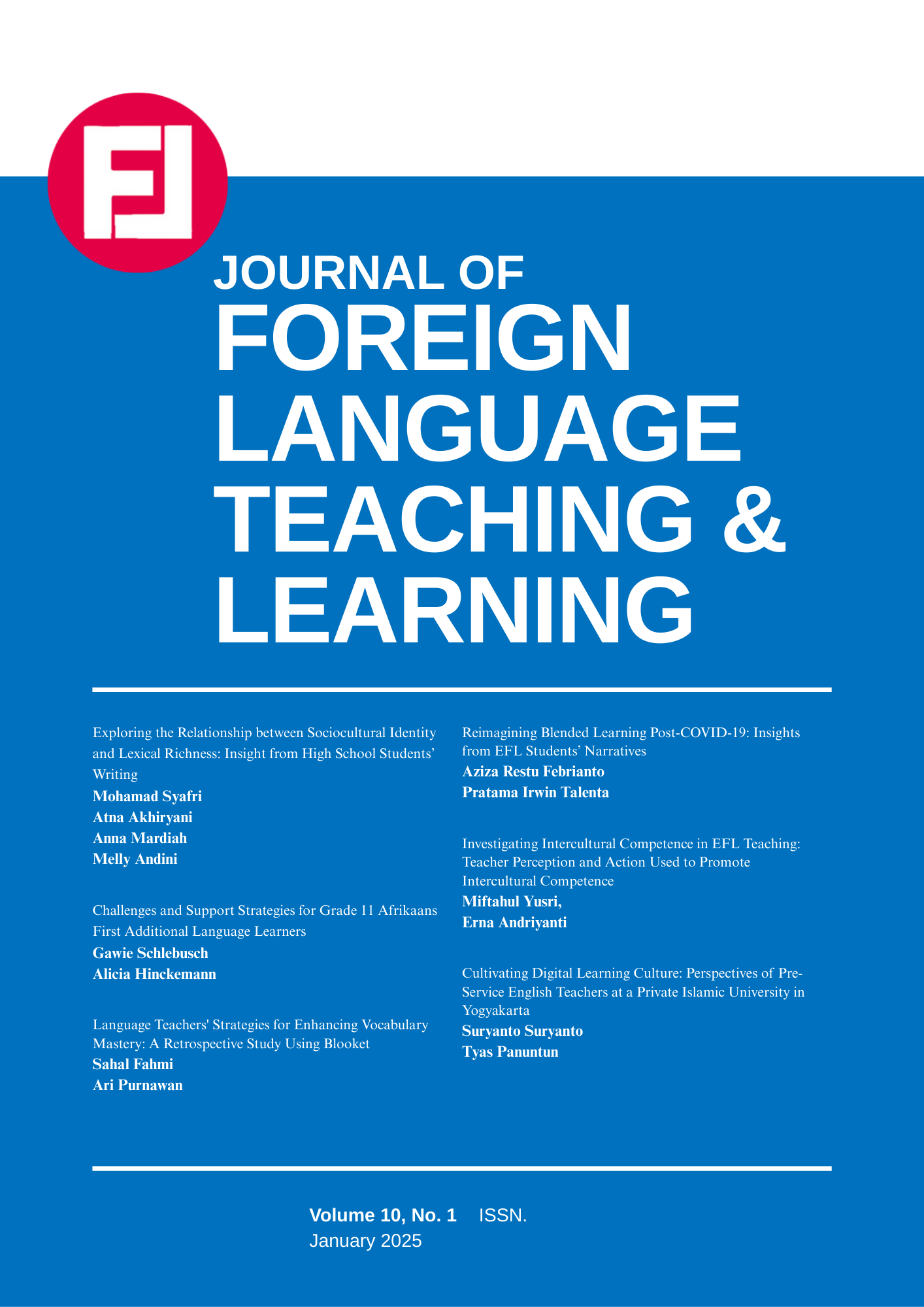Investigating Intercultural Competence in EFL Teaching: Teacher Perception and Action Used to Promote Intercultural Competence
DOI:
https://doi.org/10.18196/ftl.v10i1.25325Keywords:
EFL teaching, Intercultural competence, Intercultural pedagogyAbstract
Background: Integrating intercultural components in foreign language teaching is essential because of the interrelationship between language and culture and the need to understand native and target cultures. Integrating intercultural competence can be done appropriately if the English teacher applies appropriate teaching patterns or strategies to promote intercultural competence in the English classroom. Thus, after implementing intercultural competence, students can adapt to the global society in the future.
Objective: The study focuses on revealing (1) teacher’s perceptions of intercultural competence in EFL teaching and (2) the actions they used in promoting intercultural competence in EFL teaching in some senior high schools in two different cities, Yogyakarta and Palembang.
Methods: The research is a descriptive study that investigates EFL teachers’ perceptions and the application of intercultural competence in high school.
Findings: (1) Participants thought that intercultural competence was crucical to be taught in EFL teaching and that intercultural components such as attitudes, knowledge and skills must be introduced to students in English classroom. It is reflected in the teaching materials, teachers’ syllabi, and information directly from participants. (2) In achieving the learning goals of promoting intercultural competence, all teachers used some actions including media, small group instructions, collaborative dialog, collaborative grouping, and internet-based intercultural contact.
Conclusion: Teachers have positive perceptions of integrating of intercultural competencies practices in EFL teaching. However, teachers also faced some problems in integrating intercultural competence such as time limitations in promoting it in EFL learnig, another issue is related to the recent curriculum and EFL textbook, which does not support intercultural knowledge.
References
Abidin, M.Z., Faresta, R.A., Malisa, M., Narayana, I.G.P.P., Fitriani, L.U., Andika, J.D., & Waly, M.M. (2024). Conceptualizing and integrating intercultural communicative competence in the English Language Teaching. Diction, 32(1), 33-46 https:// doi.org/10.21831/ksi. v32i1.60441.
Bagui. H., Adder. F. Z., (2020) Promoting students’ intercultural communicative competence through English literary texts: Students’ attitudes and teachers’ challenges. Arab World English Journal,11(2), 85-93. https://eric.ed.gov/?id=EJ1265882
Banjongjit, B., & Boonmoh, A. (2018). Teachers' perceptions towards promoting intercultural communicative competence in the EFL classroom. rEFLections, 25(2), 76-97. https://doi.org/10.61508/refl.v25i2.165393
Barrett, M. (2018). How schools can promote the intercultural competence of young people. European Psychologist,23(1), 93-104. https://doi.org/10.1027/1016-9040/a000308
Byram, M., & Morgan, C. (1994). Teaching-and-Learning Language-and-Culture. Clevedon: Multilingual Matters.
Byram, M. (1997). Teaching and assessing intercultural competence. Clevedon: Multilingual Matters.
Byram, M., Gribkova, B. & Starkey, H. (2002). Developing the intercultural dimension in language teaching: A practical introduction for teachers. Council of Europe: Strasbourg.
Çelik, S., Çetinkaya, E. Ş., & Kokoç, M. (2022). Developing intercultural communicative competence through virtual reality. In A. Çekiç (Ed.), Topics in technology enhanced language learning (pp. 59-74). Sivas Cumhuriyet University Publications.
Chen, J. J., & Yang, S. C. (2016). Promoting cross-cultural understanding and language use in research-oriented Internet-mediated intercultural exchange. Computer Assisted Language Learning, 29(2), 262-288. https://doi.or g/10.1080/09588221.2014.937441
Committee for Economic Development Research and Policy Committee. (2006). Education for global leadership: The importance of international studies and foreign language education for U.S. economic and national security. Committee for Economic Development. Retrieved from https://eric.ed.gov/?id =ED502294
Creswell, J.W. (2012). Research design pendekatan kualitatif, kuantitatif, dan mixed. Yogyakarta: Pustaka Pelajar.
Czerwionka, L., Artamonova, T., & Barbosa, M. (2015). Intercultural knowledge development: Evidence from student interviews during short-term study abroad. International Journal of Intercultural Relations, 49, 80-99. https://doi.org/10.1016/j.ijintrel.2015.06.012
Deardorff, D. K. (2006). Identification and assessment of intercultural competence as a student outcome of internationalization. Journal of Studies in International Education, 10, 241-266. https://doi.org/10.1177/1028315306287002
Dervin, F. (2016). Interculturality in education—A theoretical and methodological toolbox. Palgrave Pivot.
Fungchomchoei, S., & Kardkarnklai, U. (2016). Exploring the intercultural competence of Thai secondary education teachers and its implications in teaching English language. Journal: Procedia - Social and Behavioral Sciences, 236, 240-247.
Gonen, S. K., & Saglam, S. (2012). Teaching culture in the FL classroom: Teachers' perspectives. IJGE: Innovation Journal of Global Education, 1(3), 26-46.
Hamadouch, A., & Aoumeur, H. (2024). Teachers’ perceptions towards assessing learners’ intercultural communicative competence in the EFL classroom in Algeria. JURNAL ARBITRER, 10(4), 384–390. https://doi.org/10.25077/ar.10.4.384-390.2023
Ho, S. T. K. (2011). An investigation of intercultural teaching and learning in tertiary EFL classrooms in Vietnam (Unpublished PhD Thesis). Victoria University of Wellington, Wellington, New Zealand.
Jata, E. (2015). Perception of lecturer on intercultural competence and culture teaching time (Case Study). European Journal of Interdisciplinary Studies, 1(3), 197-201.
Kothari, C. (2004). Research methodology: Methods and techniques. 2nd Edition, New Age International Publishers, New Delhi.
Kumaravadivelu, B. (2003). Beyond method: Macrostrategies for language teaching. Yale University Press, New York.
Liddicoat, A. J., & Scarino, A. (2013). Intercultural language teaching and learning. West Sussex: Wiley-Blackwell.
Lodico, M., Spaulding, D., & Voegtle, K. (2010). Methods in educational research: From theory to practice. John Wiley & Sons, San Francisco.
Moller, A. & Nugent, K. (2014). Building intercultural competence in the language classroom. Unlock the Gateway to Communication,161, 1-18.
Mostafaei Alaei, M., & Nosrati, F. (2018). Research into EFL teachers' intercultural communicative competence and intercultural sensitivity. Journal of Intercultural Communication Research, 47(2), 73-86. https://doi.org/10.1080/17475759.2018.1424020
Nguyen, T., (2013). Integrating culture into Vietnamese university EFL teaching: A critical Ethnographic study, Vietnam. (Unpublished PhD. Thesis), Auckland University of Technology, retrieved from https://core.ac.uk/download/pdf/56363954.pd 1-244.
Promwatcharanon, K. (2017). The integration of 4MAT approach with ASEAN social and cultural links: The developing an instructional model to enhance youth's intercultural communicative competence and attitudes. Journal of Studies in the English Language, 12(1), 38–69. https://so04.tci-thaijo.org/index.php/jsel/article/view/87623
Ruslin, R.,Mashuri, S., Sarib, M., Alhabsyi, F & Hijrah, S. (2022) Semi-structured interview: A methodological reflection on the development of a qualitative research instrument in educational studies. IOSR Journal of Research & Method in Education (IOSR-JRME), 12(1), 22-29. https://doi.org/10.9790/7388-1201052229
Samia, F. E. D. (2019). Intercultural communication in practice: An integration of the intercultural approach in the Algerian EFL classroom. Altralang Journal, 1(2), 93-105. https://doi.org/10.52919/altralang. v1i02.26
Samifanni, F., & Gumanit, R. L. R. (2021). Interdependent theory of intercultural communication competence. European Journal of Educational Studies, 8(11), 140-168. http://dx.doi.org/10.46827/ejes.v8i11.3978
Sercu, L., Bandura, E., Castro, P., Davcheva, L., Laskaridou, C., Lundgren, & Ryan, P. (2005). Foreign language teachers and intercultural competence: An international investigation. UK: The Cromwell Press.
Snow, D. (2015). English teaching, intercultural competence, and critical incident exercises. Language and Intercultural Communication, 15(2), 285- 299. https://doi.org/10.1080/14708477.2014.980746
Sugiyono. (2013). Metode penelitian pendidikan (Pendekatan kuantitatif, kualitatif dan R&D). Bandung: Alfabeta
Tomalin, B., & Stempleski, S. (1993). Cultural awareness. Oxford: Oxford University Press.
Wello, Muh. B., Nur, S., & Azis, A. (2017). Intercultural communication at higher education context: Portraits and practices. International Journal of Language Education, 1(2), 8-16. https://ojs.unm.ac.id/ijole/article/view/4310
Yusri, M., & Indrayanti, E. (2023). Investigating of intercultural competence and the action used to promote intercultural competence in EFL teaching in senior high school. (Unpublished Master’s Thesis). Universitas Negeri Yogyakarta, Yogyakarta, Indonesia
Zhang, X., & Zhang, J. (2015). English language teaching and intercultural communication competence. International Journal for Innovation Education and Research, 3(8), 55-59.
Downloads
Published
How to Cite
Issue
Section
License
Copyright (c) 2025 Miftahul Yusri, Erna Andriyanti

This work is licensed under a Creative Commons Attribution-ShareAlike 4.0 International License.
Copyright
Authors retain copyright and grant the journal right of first publication with the work simultaneously licensed under a Creative Commons Attribution-ShareAlike 4.0 International License that allows others to share the work with an acknowledgment of initial publication in this journal.
Authors are permitted and encouraged to post their work online (e.g., in institutional repositories, social media account, or on their website) after the article getting published in the journal, as it can lead to productive exchanges and earlier and greater citation of published work (See The Effect of Open Access).License
You are free to:
- Share — copy and redistribute the material in any medium or format
- Adapt — remix, transform, and build upon the material for any purpose, even commercially.
Attribution — You must give appropriate credit, provide a link to the license, and indicate if changes were made. You may do so in any reasonable manner, but not in any way that suggests the licensor endorses you or your use.
ShareAlike — If you remix, transform, or build upon the material, you must distribute your contributions under the same license as the original.
- No additional restrictions — You may not apply legal terms or technological measures that legally restrict others from doing anything the license permits.



.png)





